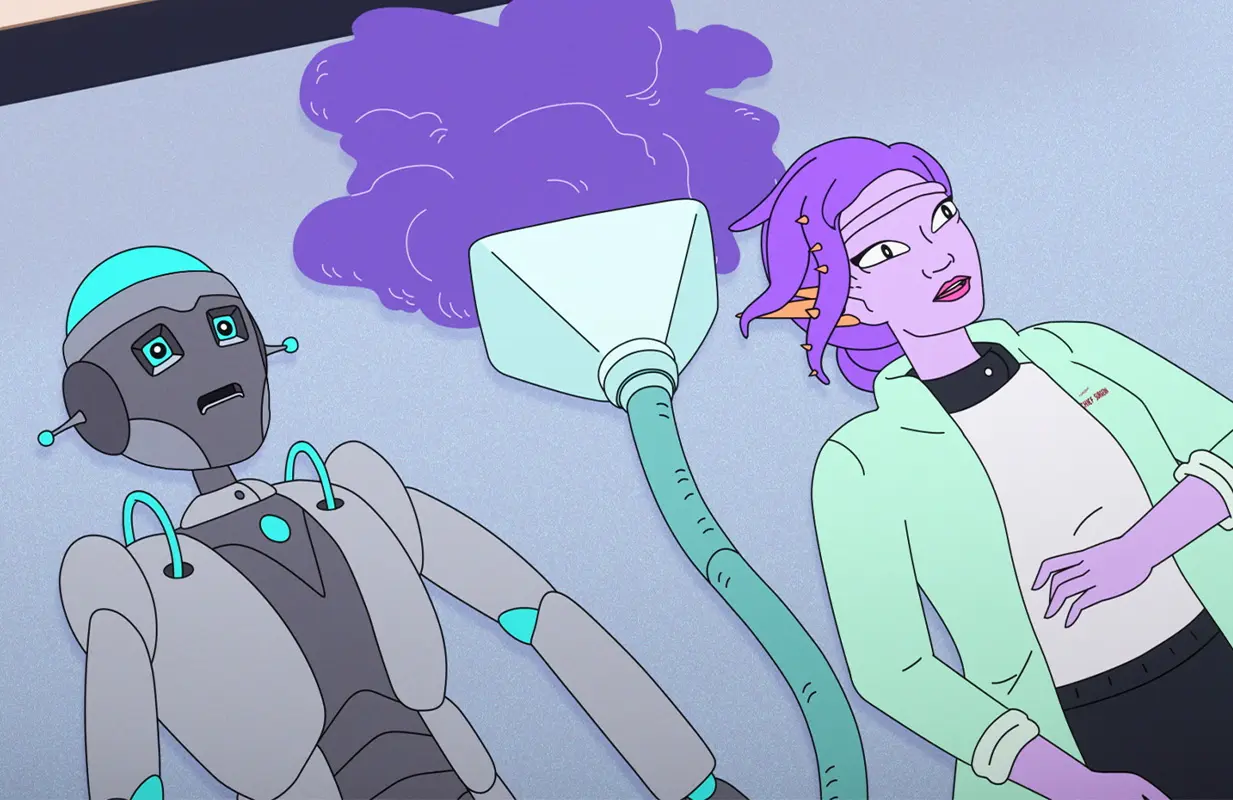The Second Best Hospital in the Galaxy Embraces the Alien
-
 The Second Best Hospital in the Galaxy (Image: Amazon Studios)
The Second Best Hospital in the Galaxy (Image: Amazon Studios)There’s nothing cut-rate about The Second Best Hospital in the Galaxy, an absurd yet emotionally grounded new series from Russian Doll writer Cirocco Dunlap. Titmouse Animation, the studio behind such visually sumptuous series as Scavengers Reign and Pantheon, and production designer Robin Eisenberg have created a galaxy teeming with life in all of its glorious — and grotesque — forms. And Stephanie Hsu and Keke Palmer, two of the most exciting actors working today, lead a cast that’s stacked from top to bottom.
That this is all often in service of gonzo storytelling — think “Star Trek meets Ugly Americans,” with some Rick and Morty thrown in for good measure — is a clear sign that Dunlap and executive producers Natasha Lyonne and Maya Rudolph (who both lend their voice talents to the show) aren’t concerned with today’s streaming mandate of making a show that’s palatable to a broad audience. They’ve harnessed the potential that animation and a game cast afford them to really get weird — sex-in-a-flying-space-whale, cloning-an-army-of-emotionally-damaged-girls, proletarian-parasite-rebellion freaky.
Even if the show, which premiered February 23 on Prime Video, rested on zaniness for the sake of zaniness, it would still be a blast of pressurized oxygen, especially at a time when inventive series struggle to stick around. The opening moments of the premiere see Drs. Klak (Palmer) and Sleech (Hsu) race to perform what turns out to be life-saving surgery on a parasitic alien, leaving its humanoid host to die. John Waters voices a dead inventor who booby-trapped his corpse and is revived during his own autopsy. In between black hole-related disasters and time-travel shenanigans, characters gleefully chow down on live creatures that look like Baby Groots (in space, cuteness won’t save you) or guzzle carbonated beverages that literally melt their insides.
It’s all a bit off-putting, and that seems to be by design: Dunlap and her team, including BoJack Horseman alum Shauna McGarry, have created a world — er, galaxy — that embraces the alien, testing the boundaries of an elastic reality as only an animated series can. But, like so many celestial bodies, The Second Best Hospital in the Galaxy also has an inner core that keeps its disparate elements from flying off in every direction. No matter how bizarre the creature or storyline, it still feels deeply human. Dr. Plowp (an endearing Kieran Culkin) is a member of an avian species that goes through multiple puberties; his empathic abilities might be out of this world, but his struggle to contain his raging hormones isn’t. His colleague Dr. Vlam (Rudolph, voicing another breakout character) is an immortal robot now trying her metallic hand at medicine, and her journey to reconcile her many past lives provides some of the show’s most poignant moments.
What makes Season 1 such a success is its ability to fuse the foreign with the familiar — hardly a first for a genre show (which is what TSBHITG ultimately is), we realize, but it’s still important to note. Dunlap and co. find all kinds of inspired ways to root intergalactic adventures in something relatable, from the blending of workplace comedy with space-faring exploits to irreverent nods to the creator and cast’s previous work, including Russian Doll and Forever. Episode 2, “The Land of Sex and Death,” combines a riff on “The Naked Now” with an extended callback to Scott Pilgrim vs. the World. But if those references are lost on you, you should still enjoy the episode’s play on the old “sex as death” metaphor, as narrated by Tracee Ellis Ross (to say nothing of the group Culkin cameo).
As befits their lead roles, though, Klak and Sleech are our guides through space, which is rendered alluring and threatening in equal parts. Like their forebears Tuca and Bertie, Klak and Sleech are complementary opposites who drive each other to succeed… and also a bit nuts. Sleech’s overachieving personality and Klak’s struggle with anxiety make for compelling stories on their own, but they frequently intersect, providing much of the show’s pathos. Late in the season, we learn the extent to which Klak’s psychiatrist mother (also voiced by Ross) attempted to “fix” her daughter; the experiments border on “Thanos and Nebula” territory. Sleech’s avoidant attachment style might stymie her character growth, but she keeps trying, especially for Klak. Though the details might not all hit home, their emotional journeys resonate.
But The Second Best Hospital in the Galaxy’s most distinctive feature is one that isn't exactly visible on the screen and yet informs every single scene. It’s one of the rarest types of TV shows: a female-led animated comedy. Though animation isn’t uncharted territory for women or genderqueer creators, the landscape isn’t heavily populated with their shows, either. Dunlap, Lyonne, Hsu, Palmer, and Rudolph — and the broader cast, which includes Lennon Parham and Sam Smith — are boldly going where mostly cis men have gone before, and with a second season already ordered, hopefully setting up more than just an outpost.
The Second Best Hospital in the Galaxy Season 1 is streaming on Prime Video.
Danette Chavez is the Editor-in-Chief of Primetimer and its biggest fan of puns.
TOPICS: The Second Best Hospital in the Galaxy, Prime Video, Cirocco Dunlap, Keke Palmer, Lennon Parham, Natasha Lyonne, Sam Smith, Shauna McGarry, Stephanie Hsu, Tracee Ellis Ross, Animation